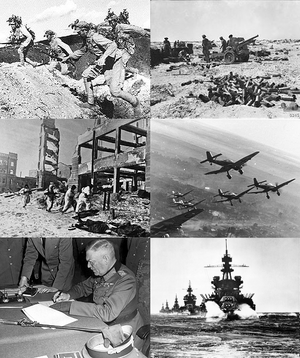This is an old revision of this page, as edited by Bright Darkness (talk | contribs) at 15:56, 28 April 2013 (Why removing de Gaulle, he was a prominent character. I advise to seek consensus for the collapsible list idea.). The present address (URL) is a permanent link to this revision, which may differ significantly from the current revision.
Revision as of 15:56, 28 April 2013 by Bright Darkness (talk | contribs) (Why removing de Gaulle, he was a prominent character. I advise to seek consensus for the collapsible list idea.)(diff) ← Previous revision | Latest revision (diff) | Newer revision → (diff)| World War II | |||||||
|---|---|---|---|---|---|---|---|
 Clockwise from top left: Chinese forces in the Battle of Wanjialing, Australian 25-pounder guns during the First Battle of El Alamein, German Stuka dive bombers on the Eastern Front winter 1943–1944, US naval force in the Lingayen Gulf, Wilhelm Keitel signing the German Instrument of Surrender, Soviet troops in the Battle of Stalingrad | |||||||
| |||||||
| Belligerents | |||||||
|
Allies Client and puppet states |
Axis Co-belligerents Client and puppet states | ||||||
| Commanders and leaders | |||||||
|
|
| ||||||
| Casualties and losses | |||||||
|
Military dead: Over 16,000,000 Civilian dead: Over 45,000,000 Total dead: Over 61,000,000 (1937–45) ...further details |
Military dead: Over 8,000,000 Civilian dead: Over 4,000,000 Total dead: Over 12,000,000 (1937–45) ...further details | ||||||
| World War II |
|---|
| Navigation |
References
- Footnotes
- After the fall of the Third Republic in 1940, the de facto government was the Vichy Regime. It conducted pro-Axis policies until November 1942 while remaining formally neutral. The Free French Forces, based out of London, were recognized by all Allies as the official government in September 1944.